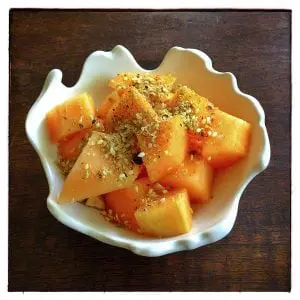By Joe Dizney
It’s the little touches that ultimately keep things interesting at table. Condiments and flavorful garnishes: versatile, flexible and adaptable. Sometimes the simplest culinary idea from an exotic culture, when formally examined suggests enjoyment far beyond its use. This is not appropriation; rather, it’s adaptation.
Take dukkah (also known as duqqa or du’ah), a dry, crumbly Egyptian blend of roasted or toasted nuts, seeds and spices. (The name is the Arabic description of the process of its manufacture: “to pound” or “to crush.”) Dukkah’s crunch and intense flavor make it both a great snack food and condiment. It is most commonly eaten with breads or flatbreads —sprinkled on top or with the bread first dipped in olive oil and then dredged in the blend.

Egyptian-born food writer Claudia Roden is universally acknowledged as popularizing the basic ur-recipe (her mother’s!) in her 1968 classic, A Book of Middle Eastern Food. For some reason, Aussies and Kiwis were the first to heartily embrace Roden’s culinary diaspora and have developed a serious culture of the blend. But contemporary chefs such as Yotam Ottolenghi and Ana Sortun have further promoted and updated this Middle Eastern staple for Western palates.
Basic ingredients vary wildly, though the most common (and those in Roden’s classic formula) are hazelnuts; sesame, cumin and coriander seeds, and salt and pepper. Substitutions and regional variations include nigella (black cumin), marjoram, mint, oregano, thyme, savory, sumac, dried chickpeas, millet flour, dried cheese, peanuts, almonds, cashews, pine nuts and pumpkin or sunflower seeds.
And just as the list of ingredients suggests endless variation, an extensive menu of uses has come into being:
- Stir dukkah into yogurt as a dip, or use as garnish for soup
- Fold it into hummus for chips or crudité
- Roll goat cheese logs or discs in dukkah; serve cold or baked for salads
- Whisk some into plain vinaigrette for variety
- Toss vegetables with dukkah and olive oil before or after roasting. Pumpkin, carrots, cauliflower or beets really benefit from this treatment.
- Sprinkle some on top of crisp greens, cooked beans, or bruschetta, or atop poached, fried, scrambled or deviled eggs before serving.
- Toss with grains or pasta
- Coat meat (chicken or lamb) or fish before grilling, roasting or pan-frying. Place items on a rack over a sheet pan and rest in the refrigerator uncovered for 4 to 6 hours before cooking to boost flavor.
- Sprinkle over grilled or barbecued meat after taking it off the grill
The exceptional adaptability of dukkah’s crunchy taste and texture suggest seasonal or regional variations: maybe a Tex-Mex version to finish the end.
More interesting still are sweet dukkahs, sprinkled over seasonal fruits, pots de crème, puddings, brûlées, ice cream or other dessert courses. I had a major success with a mixture of ½ cup hazelnuts, ¼ cup toasted coconut, ¼ cup cocoa nibs, a tablespoon of organic vanilla powder and raw sugar to taste, dusting 1½-to-2 tablespoons over vanilla ice cream.
Basic Sweet Dukkah
Makes just over 1 cup
½ cup hazelnuts
¼ cup unsweetened shredded coconut
¼ cup sesame seeds
1/2 teaspoon finely grated orange zest
1 tablespoon raw sugar (or coconut or date sugar)
Pinch of sea salt
Suggested substitutions: Nuts (same as for savory recipe), seeds (caraway, fennel, cocoa nibs), ground spices (cinnamon, vanilla powder, dried ginger, saffron), exotics (dried lavender, dried rose petals).
Basic Savory Dukkah
Makes just over 1 cup
½ cup hazelnuts
¼ cup sesame seeds
¼ cup coriander seeds
3 tablespoons cumin seeds
1 teaspoon ground sumac (substitute ½ teaspoon finely grated lemon zest)
1 teaspoon freshly ground pepper
1 teaspoon salt
Suggested substitutions: Nuts (almonds, peanuts, pistachios, pine nuts, walnuts, Macadamias), seeds (caraway, dill, fennel, nigella), ground spices (smoked paprika, Cayenne pepper), dried herbs (thyme, mint).
Basic directions for Savory or Sweet Dukkah
Preheat oven to 350 degrees. Roast nuts on a baking sheet, in individual batches, for about 10 minutes, until golden. Be careful not to burn them. (Hazelnuts need be skinned after roasting. Wrap nuts in a kitchen towel and let them steam for 1 minute. Rub them in towel to remove loose skins.) Cool completely and coarsely chop by hand or pulse in a food processor or grinder and reserve.
Heat a small skillet to medium-high and again in individual batches, toast the seeds, shaking the pan or stirring constantly until each is fragrant and just starting to smell toasted (about 2 minutes each for the cumin and coriander; 3 to 4 minutes for the sesame seeds.) Remove from the pan and cool completely.
Pulse the nuts and seeds in a spice mill or grinder to a coarse powder. Sesame seeds may be used whole or partly ground, but be careful not to reduce them to a paste. The final mixture should be relatively dry and crunchy. Transfer all ingredients to a bowl and stir to combine and season with salt, pepper or sugar as per the ingredients list. Dukkah may be kept up in a jar in the freezer for up to a month.

